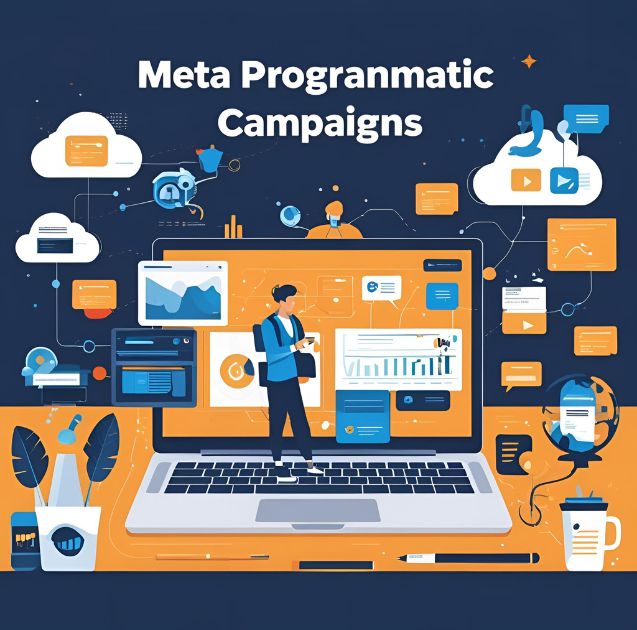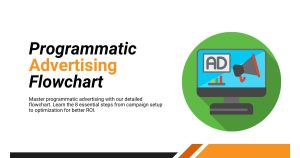Meta Programmatic Advertising: Your Complete Guide for 2025

Meta programmatic advertising has revolutionized how businesses reach their target audiences across Facebook, Instagram, and other Meta platforms. By automating ad buying and optimization processes, this sophisticated approach allows marketers to deliver highly targeted campaigns with unprecedented precision and efficiency.
This comprehensive guide explores everything you need to know about Meta programmatic advertising, from fundamental concepts to advanced strategies. You’ll discover how to leverage Meta’s powerful advertising ecosystem to maximize your return on investment, improve campaign performance, and scale your marketing efforts effectively.
Whether you’re new to programmatic advertising or looking to enhance your existing Meta campaigns, this post provides actionable insights to help you navigate the complex landscape of automated advertising on the world’s largest social media platforms.
What Is Meta Programmatic Advertising?

Meta programmatic advertising refers to the automated buying, placement, and optimization of ads across Meta’s family of platforms, including Facebook, Instagram, Messenger, and the Audience Network. This technology-driven approach uses real-time bidding (RTB) and machine learning algorithms to purchase ad inventory and deliver targeted messages to specific audience segments.
Unlike traditional advertising methods that require manual negotiations and placements, Meta’s programmatic system makes split-second decisions about which ads to show to which users. The platform analyzes vast amounts of user data, including demographics, interests, behaviors, and past interactions, to determine the most relevant advertisements for each individual.
The programmatic process happens in milliseconds. When a user opens their Facebook or Instagram feed, Meta’s algorithm instantly evaluates available ad inventory, considers the user’s profile and preferences, and conducts an automated auction among advertisers competing for that ad space. The winning ad appears in the user’s feed, all before the page fully loads.
How Meta Programmatic Advertising Works
Meta’s programmatic advertising ecosystem operates through a sophisticated network of interconnected systems and data sources. At its core, the platform combines first-party data from user interactions with advanced machine learning capabilities to create highly targeted advertising experiences.
Data Collection and Analysis
Meta collects extensive user data through various touchpoints across its platforms. This includes explicit information users provide, such as age, location, and interests, as well as implicit behavioral data like pages liked, posts shared, and time spent viewing different content types. The platform also tracks user interactions with businesses, including website visits, app downloads, and purchase behaviors through tools like the Facebook Pixel.
This comprehensive data collection enables Meta to create detailed user profiles and audience segments. The platform’s algorithms continuously analyze patterns in user behavior to predict preferences, likelihood to engage with certain content, and propensity to take specific actions like making purchases or signing up for services.
Real-Time Bidding Process
When ad inventory becomes available, Meta’s programmatic system initiates an automated auction process. Advertisers set their target audiences, budgets, and bidding strategies through Meta’s Ads Manager or API integrations. The system then evaluates which ads are eligible for each available impression based on targeting criteria.
The auction considers multiple factors beyond just bid amount, including ad relevance, expected engagement rates, and overall user experience. Meta’s algorithm aims to show users the most relevant and engaging ads while maximizing revenue for the platform and value for advertisers.
Campaign Optimization
Meta’s programmatic system continuously optimizes campaigns based on performance data and machine learning insights. The platform automatically adjusts bidding strategies, reallocates budget between ad sets, and modifies targeting parameters to improve campaign outcomes. This dynamic optimization happens without manual intervention, allowing advertisers to achieve better results with less hands-on management.
Benefits of Meta Programmatic Advertising
Enhanced Targeting Precision
Meta programmatic advertising offers unparalleled targeting capabilities that enable advertisers to reach highly specific audience segments. The platform’s extensive user data allows for detailed demographic, psychographic, and behavioral targeting options. Advertisers can create custom audiences based on website visitors, email subscribers, or app users, and build lookalike audiences to find similar high-value prospects.
Interest-based targeting leverages Meta’s understanding of user preferences to reach people interested in specific topics, brands, or activities. Behavioral targeting identifies users based on their actions, such as online shopping habits, travel patterns, or device usage. These sophisticated targeting options help advertisers minimize waste and maximize relevance.
Improved Efficiency and Scale
Programmatic advertising eliminates the need for manual campaign management tasks, freeing up valuable time for strategic planning and creative development. The automated optimization process continuously improves campaign performance, often achieving better results than manual management approaches.
The scalability of programmatic advertising allows businesses to expand their reach across Meta’s entire ecosystem without proportional increases in management overhead. Campaigns can automatically adjust to accommodate budget increases, new market expansions, or seasonal demand fluctuations.
Real-Time Performance Insights
Meta’s programmatic platform provides comprehensive analytics and reporting capabilities that offer deep insights into campaign performance. Advertisers can track metrics across the entire customer journey, from initial impressions to final conversions, enabling data-driven optimization decisions.
The platform’s attribution modeling helps advertisers understand the role different touchpoints play in the conversion process. This insight enables more effective budget allocation and campaign strategy adjustments based on actual performance data rather than assumptions.
Cost Effectiveness
Automated bidding strategies help advertisers achieve their desired outcomes at optimal costs. Meta’s algorithm considers factors like competition levels, audience size, and historical performance data to determine appropriate bid amounts for each auction. This dynamic approach often results in lower costs per acquisition compared to manual bidding methods.
The platform’s ability to identify and prioritize high-value opportunities also improves return on ad spend. By automatically allocating more budget to better-performing audiences and placements, programmatic campaigns often achieve superior cost efficiency.
Setting Up Meta Programmatic Campaigns

Campaign Objective Selection
The foundation of successful Meta programmatic advertising begins with selecting the appropriate campaign objective. Meta offers various objectives aligned with different stages of the marketing funnel, including awareness, consideration, and conversion goals. Each objective optimizes the campaign for specific outcomes and determines which optimization options are available.
Awareness objectives focus on reaching the maximum number of people within your target audience or generating impressions among users most likely to remember your ads. Consideration objectives optimize for engagement metrics like link clicks, video views, or lead generation. Conversion objectives prioritize actions like purchases, app installs, or other valuable customer behaviors.
Audience Definition and Segmentation
Creating well-defined audience segments is crucial for programmatic campaign success. Start by analyzing your existing customer data to identify common characteristics, preferences, and behaviors among your most valuable customers. Use this information to build detailed buyer personas that guide your targeting strategy.
Meta’s audience creation tools allow for layered targeting that combines multiple criteria for precise audience definition. Consider factors like demographics, interests, behaviors, and connections to create highly specific segments. Test different audience combinations to identify which groups respond best to your messaging and offers.
Custom audiences enable you to target existing customers or website visitors with tailored messages. Upload customer lists, use pixel data to create website visitor audiences, or target people who have engaged with your previous ads or social media content.
Creative Strategy and Testing
Programmatic advertising success heavily depends on creative quality and relevance. Develop multiple creative variations to test different messaging approaches, visual styles, and calls-to-action. Meta’s dynamic creative optimization feature automatically tests different combinations of creative elements to identify top-performing versions.
Consider the unique characteristics of each placement when developing creative assets. Instagram Stories require vertical video formats, while Facebook feed placements work well with square or horizontal orientations. Native-style creatives that blend naturally with organic content typically achieve better engagement rates.
Video content often outperforms static images across Meta platforms, particularly for engagement and brand awareness objectives. Create thumb-stopping content that captures attention quickly and communicates your value proposition effectively within the first few seconds.
Budget and Bidding Strategy
Meta offers several bidding strategies optimized for different campaign goals. Cost per result bidding aims to achieve the lowest cost per desired action, while target cost bidding maintains consistent costs around a specified amount. Bid cap strategies allow maximum control over individual auction bids.
Budget allocation decisions significantly impact campaign performance. Campaign budget optimization automatically distributes budget across ad sets based on performance, while ad set-level budgets provide more granular control. Start with campaign budget optimization for most scenarios, as Meta’s algorithm typically outperforms manual budget distribution.
Consider your profit margins and customer lifetime value when setting target costs or bid caps. Allow sufficient budget for the algorithm to gather performance data and optimize effectively, particularly during the initial learning phase.
Advanced Meta Programmatic Strategies
Cross-Platform Integration
Maximize your programmatic advertising impact by integrating Meta campaigns with broader marketing initiatives. Coordinate messaging across email, search, display, and other channels to create cohesive customer experiences. Use Meta’s offline conversion tracking to measure the impact of social media advertising on in-store purchases or phone inquiries.
Implement sequential messaging strategies that guide prospects through the customer journey with appropriate content at each stage. Start with awareness-focused creatives for cold audiences, followed by consideration-focused messaging for engaged users, and conversion-focused offers for warm prospects.
Automated Rules and Optimization
Meta’s automated rules feature enables hands-off campaign management by automatically implementing changes based on predetermined conditions. Create rules that pause underperforming ad sets, increase budgets for successful campaigns, or send notifications when key metrics exceed specified thresholds.
Advanced advertisers can use Meta’s API to implement sophisticated optimization strategies beyond the platform’s built-in features. Custom optimization rules can incorporate external data sources, implement complex bidding logic, or automate creative rotation based on performance patterns.
Attribution and Measurement
Implement comprehensive measurement strategies that account for Meta’s role in multi-touch customer journeys. Use Meta’s attribution modeling tools to understand how social media advertising influences conversions across different time windows and interaction points.
Consider incrementality testing to measure the true impact of your Meta advertising efforts. Holdout tests compare results between audiences exposed to your ads and control groups that don’t see them, providing insights into the actual lift generated by your campaigns.
Common Challenges and Solutions
Ad Fatigue Management
Programmatic campaigns can suffer from ad fatigue when audiences see the same creative content repeatedly, leading to declining engagement rates and increasing costs. Combat this challenge by implementing systematic creative rotation strategies and monitoring frequency metrics closely.
Develop content calendars that introduce new creative variations regularly, and use Meta’s creative testing tools to identify fresh approaches that resonate with your audience. Set up automated rules to pause ads when frequency levels become excessive or performance metrics deteriorate.
iOS 14.5+ Privacy Updates
Apple’s iOS updates have significantly impacted programmatic advertising tracking and optimization capabilities. Adapt to these changes by implementing server-side tracking solutions, focusing on first-party data collection, and adjusting attribution windows to account for reduced tracking capabilities.
Invest in building direct customer relationships through email lists, loyalty programs, and first-party data collection initiatives. These owned data sources become increasingly valuable as third-party tracking becomes more limited.
Competition and Rising Costs
Increased competition on Meta platforms has driven up advertising costs across many industries. Counter this challenge by improving ad relevance through better targeting, more engaging creative content, and stronger value propositions.
Focus on lifetime value optimization rather than just acquisition costs. Customers acquired through higher-cost channels may generate superior long-term value, making seemingly expensive campaigns profitable over extended time periods.
Maximizing Your Meta Programmatic Success
Meta programmatic advertising represents a powerful opportunity for businesses to reach targeted audiences with precision and efficiency. Success requires a strategic approach that combines data-driven targeting, compelling creative content, and continuous optimization based on performance insights.
The key to programmatic advertising success lies in embracing automation while maintaining strategic oversight. Allow Meta’s algorithms to handle routine optimization tasks while focusing your efforts on audience strategy, creative development, and overall campaign direction. Regular testing and iteration will help you stay ahead of changing platform dynamics and audience preferences.
Start by implementing the fundamentals covered in this guide, then gradually incorporate advanced strategies as you gain experience and confidence with the platform. Remember that programmatic advertising is an ongoing process of learning and optimization rather than a set-it-and-forget-it solution.





